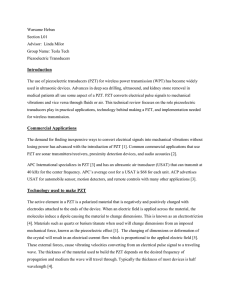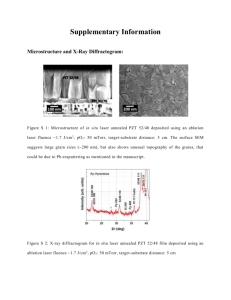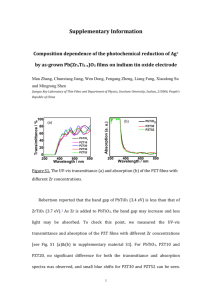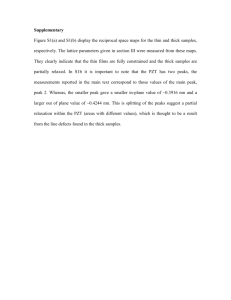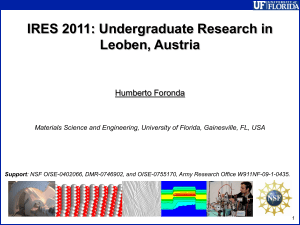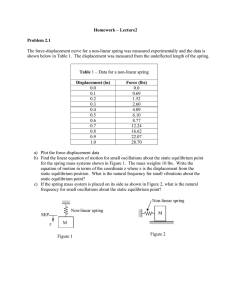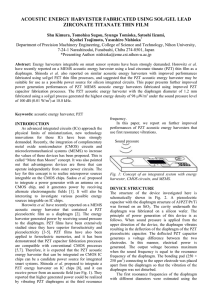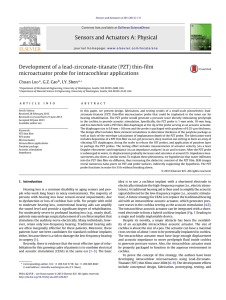Investigation of the Acoustic Properties of Piezoelectric Diaphragms
advertisement
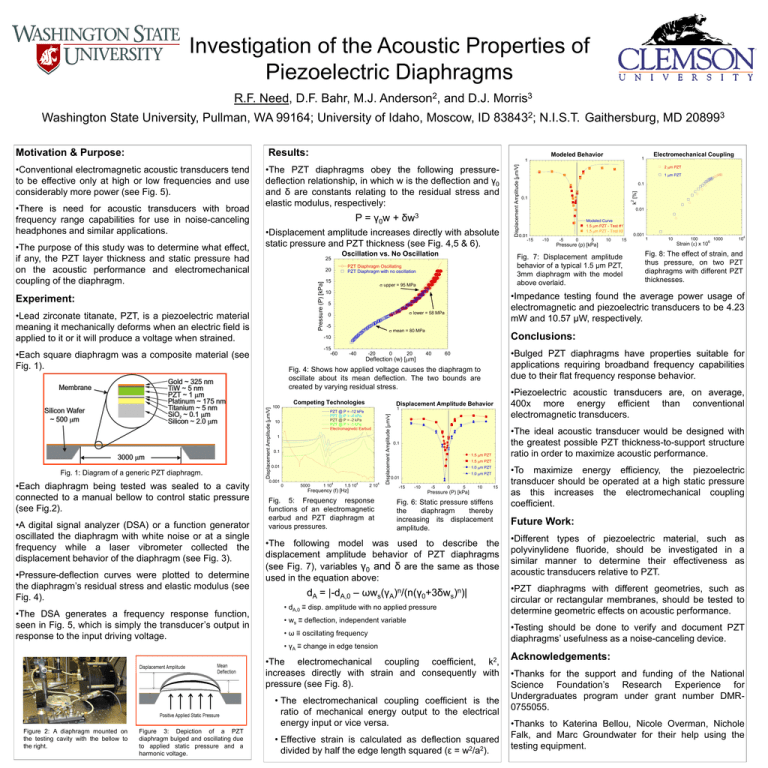
Investigation of the Acoustic Properties of Piezoelectric Diaphragms R.F. Need, D.F. Bahr, M.J. 2 Anderson , 3 Morris and D.J. 2 83843 ; Washington State University, Pullman, WA 99164; University of Idaho, Moscow, ID Motivation & Purpose: N.I.S.T. Gaithersburg, MD Results: Modeled Behavior •The purpose of this study was to determine what effect, if any, the PZT layer thickness and static pressure had on the acoustic performance and electromechanical coupling of the diaphragm. •Displacement amplitude increases directly with absolute static pressure and PZT thickness (see Fig. 4,5 & 6). 25 20 Experiment: •Lead zirconate titanate, PZT, is a piezoelectric material meaning it mechanically deforms when an electric field is applied to it or it will produce a voltage when strained. •Each diaphragm being tested was sealed to a cavity connected to a manual bellow to control static pressure (see Fig.2). •A digital signal analyzer (DSA) or a function generator oscillated the diaphragm with white noise or at a single frequency while a laser vibrometer collected the displacement behavior of the diaphragm (see Fig. 3). •Pressure-deflection curves were plotted to determine the diaphragm’s residual stress and elastic modulus (see Fig. 4). •The DSA generates a frequency response function, seen in Fig. 5, which is simply the transducer’s output in response to the input driving voltage. PZT Diaphragm Oscillating PZT Diaphragm with no oscillation 15 upper = 95 MPa 10 lower = 58 MPa mean = 80 MPa -40 -20 0 20 40 Displacement Amplitude [ m/V] Competing Technologies Displacement Amplitude Behavior PZT @ P = -12 kPa PZT @ P = -4 kPa PZT @ P = -2 kPa PZT @ P = -1 kPa Electromagnetic Earbud 1 0.1 0.01 0 5000 1 104 1.5 104 2 104 Frequency (f) [Hz] 1 0.1 1.5 m PZT k [%] 2 -10 -5 0 5 10 15 Pressure (p) [kPa] 0.001 1 10 100 Strain ( ) x 106 1000 4 10 Fig. 8: The effect of strain, and thus pressure, on two PZT diaphragms with different PZT thicknesses. 1.0 m PZT 1.0 m PZT 0.01 -15 -10 -5 0 5 10 15 Pressure (P) [kPa] Fig. 5: Frequency response functions of an electromagnetic earbud and PZT diaphragm at various pressures. Fig. 6: Static pressure stiffens the diaphragm thereby increasing its displacement amplitude. •The following model was used to describe the displacement amplitude behavior of PZT diaphragms (see Fig. 7), variables γ0 and δ are the same as those used in the equation above: dA = |-dA,0 – •Piezoelectric acoustic transducers are, on average, 400x more energy efficient than conventional electromagnetic transducers. 1.5 m PZT •To maximize energy efficiency, the piezoelectric transducer should be operated at a high static pressure as this increases the electromechanical coupling coefficient. Future Work: •Different types of piezoelectric material, such as polyvinylidene fluoride, should be investigated in a similar manner to determine their effectiveness as acoustic transducers relative to PZT. •PZT diaphragms with different geometries, such as circular or rectangular membranes, should be tested to determine geometric effects on acoustic performance. ωws(γA)n/(n(γ0+3δws)n)| • dA,0 ≡ disp. amplitude with no applied pressure • ws ≡ deflection, independent variable •Testing should be done to verify and document PZT diaphragms’ usefulness as a noise-canceling device. • ω ≡ oscillating frequency •The electromechanical coupling coefficient, increases directly with strain and consequently with pressure (see Fig. 8). k2, • The electromechanical coupling coefficient is the ratio of mechanical energy output to the electrical energy input or vice versa. Figure 3: Depiction of a PZT diaphragm bulged and oscillating due to applied static pressure and a harmonic voltage. Modeled Curve 1.5 m PZT - Test #1 1.5 m PZT - Test #2 •The ideal acoustic transducer would be designed with the greatest possible PZT thickness-to-support structure ratio in order to maximize acoustic performance. • γA ≡ change in edge tension Figure 2: A diaphragm mounted on the testing cavity with the bellow to the right. 0.01 -15 0.01 •Bulged PZT diaphragms have properties suitable for applications requiring broadband frequency capabilities due to their flat frequency response behavior. 60 Fig. 4: Shows how applied voltage causes the diaphragm to oscillate about its mean deflection. The two bounds are created by varying residual stress. 0.001 0.1 Conclusions: Deflection (w) [ m] 10 0.1 -5 -15 -60 100 1 m PZT •Impedance testing found the average power usage of electromagnetic and piezoelectric transducers to be 4.23 mW and 10.57 µW, respectively. 5 0 2 m PZT Fig. 7: Displacement amplitude behavior of a typical 1.5 µm PZT, 3mm diaphragm with the model above overlaid. -10 •Each square diaphragm was a composite material (see Fig. 1). Fig. 1: Diagram of a generic PZT diaphragm. Oscillation vs. No Oscillation Displacement Amplitude [ m/V] P = γ0w + δw3 Displacement Amplitude [ m/v] •There is need for acoustic transducers with broad frequency range capabilities for use in noise-canceling headphones and similar applications. •The PZT diaphragms obey the following pressuredeflection relationship, in which w is the deflection and γ0 and δ are constants relating to the residual stress and elastic modulus, respectively: Pressure (P) [kPa] •Conventional electromagnetic acoustic transducers tend to be effective only at high or low frequencies and use considerably more power (see Fig. 5). Electromechanical Coupling 1 1 3 20899 • Effective strain is calculated as deflection squared divided by half the edge length squared (ε = w2/a2). Acknowledgements: •Thanks for the support and funding of the National Science Foundation’s Research Experience for Undergraduates program under grant number DMR0755055. •Thanks to Katerina Bellou, Nicole Overman, Nichole Falk, and Marc Groundwater for their help using the testing equipment.
